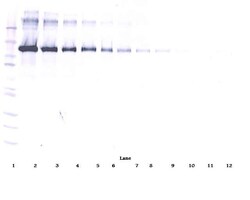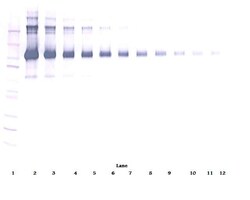Learn More
Invitrogen™ CD22 (soluble) Polyclonal Antibody, Biotin, PeproTech®, Invitrogen™
Rabbit Polyclonal Antibody
Supplier: Invitrogen™ 500P227BT500UG

Description
AA Seq. of rec. protein: SKWVFEHPET LYAWEGACVW IPCTYRALDG DLESFILFHN PEYNKNTSKF DGTRLYESTK DGKVPSEQKR VQFLGDKNKN CTLSIHPVHL NDSGQLGLRM ESKTEKWMER IHLNVSERPF PPHIQLPPEI QESQEVTLTC LLNFSCYGYP IQLQWLLEGV PMRQAAVTST SLTIKSVFTR SELKFSPQWS HHGKIVTCQL QDADGKFLSN DTVQLNVKHT PKLEIKVTPS DAIVREGDSV TMTCEVSSSN PEYTTVSWLK DGTSLKKQNT FTLNLREVTK DQSGKYCCQV SNDVGPGRSE EVFLQVQYAP EPSTVQILHS PAVEGSQVEF LCMSLANPLP TNYTWYHNGK EMQGRTEEKV HIPKILPWHA GTYSCVAENI LGTGQRGPGA ELDVQYPPKK VTTVIQNPMP IREGDTVTLS CNYNSSNPSV TRYEWKPHGA WEEPSLGVLK IQNVGWDNTT IACARCNSWC SWASPVALNV QYAPRDVRVR KIKPLSEIHS GNSVSLQCDF SSSHPKEVQF FWEKNGRLLG KESQLNFDSI SPEDAGSYSC WVNNSIGQTA SKAWTLEVLY APRRLRVSMS PGDQVMEGKS ATLTCESDAN PPVSHYTWFD WNNQSLPHHS QKLRLEPVKV QHSGAYWCQG TNSVGKGRSP LSTLTVYYSP ETIGRR. Sandwich ELISA: To detect hCD22 by sandwich ELISA (using 100 uL/well antibody solution) a conc. of 0.25-1.0 ug/mL of this antibody is required. This biotinylated polyclonal antibody, in conjunction with PeproTech Polyclonal Anti-Hu CD22 (500-P227) as a capture antibody, allows the detection of at least 0.2-0.4 ng/well of rec. hCD22. WB: To detect hCD22 by WB analysis this antibody can be used at a conc. of 0.1-0.2 ug/mL. Used in conjunction with compatible secondary reagents the detection limit for rec. hCD22 is 1.5-3.0 ng/lane, under either reducing or non-reducing conditions.
CD22, also known as BL-CAM, is a type I transmembrane glycoprotein composed of two polypeptide chains, CD22alpha and CD22beta, with molecular weights of 130 and 140 kDa, respectively. These chains are produced by alternative splicing of the CD22 gene. CD22 is prominently expressed on mature B cells and B cell lymphomas, including hairy cell leukemia, diffuse large B-cell lymphoma, and nodular lymphocyte predominance Hodgkin's lymphoma, but is negative in classical Hodgkin's lymphoma. The extracellular portion of CD22 contains seven Ig-like domains that preferentially bind alpha2,6-linked sialic acid moieties found on epithelial, endothelial, B, and T cells. This binding can be masked by cis interactions with sialic acids on the same cell surface. CD22 expression is limited to late stages of B-cell differentiation, making it useful for phenotyping mature leukemias. Intracellularly, CD22 features six tyrosine residues within immunotyrosine-based inhibitory motifs (ITIM) and activation-like motifs. These residues are phosphorylated upon B-cell receptor engagement, allowing CD22 to regulate B-cell receptor signaling. CD22 participates in positive regulation through interactions with Src family tyrosine kinases and acts as an inhibitory receptor by recruiting cytoplasmic phosphatases via SH2 domains, which block signal transduction through dephosphorylation of signaling molecules. CD22's role in both positive and negative regulation of B-cell signaling, along with its specific expression pattern, makes it a valuable marker for antibody customers interested in B-cell-related research and diagnostics.
Specifications
| CD22 (soluble) | |
| Polyclonal | |
| Biotin | |
| CD22 | |
| A530093D23; B-cell receptor CD22; BL-CAM; B-lymphocyte cell adhesion molecule; B-lymphocyte cell adhesion molecule (BL-CAM); Cd22; CD22 antigen; CD22 molecule; FLJ22814; Lectin 2; Leu-14; Lyb8; Lyb-8; MGC130020; sialic acid binding Ig-like lectin 2; sialic acid-binding Ig-like lectin 2; Sialic acid-binding Ig-like lectin 2 (Siglec-2); Siglec2; Siglec-2; T-cell surface antigen Leu-14 | |
| Rabbit | |
| Antigen affinity chromatography | |
| RUO | |
| 933 | |
| -20°C | |
| Lyophilized |
| ELISA, Western Blot | |
| 0.1-1.0 mg/mL | |
| PBS with no preservative | |
| P20273 | |
| CD22 | |
| CHO cells-derived Recombinant Human sCD22. | |
| 500 μg | |
| Primary | |
| Human | |
| Antibody | |
| IgG |
The Fisher Scientific Encompass Program offers items which are not part of our distribution portfolio. These products typically do not have pictures or detailed descriptions. However, we are committed to improving your shopping experience. Please use the form below to provide feedback related to the content on this product.




